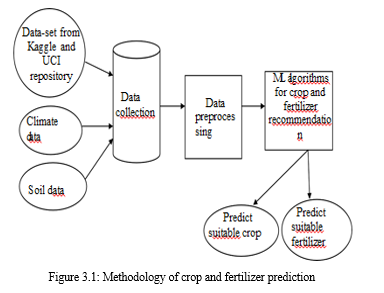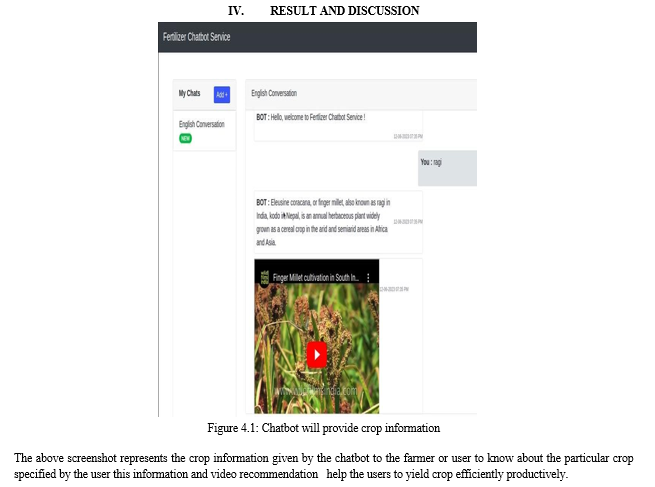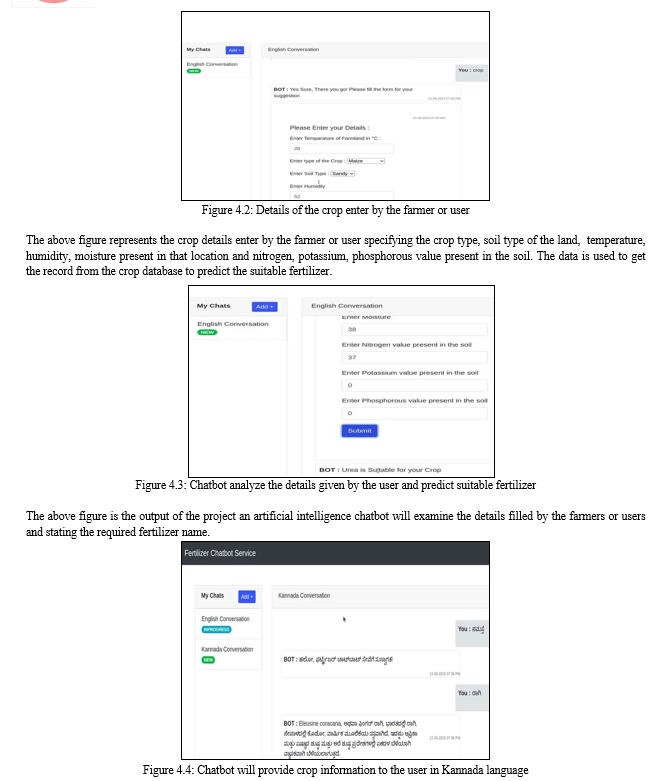Ijraset Journal For Research in Applied Science and Engineering Technology
- Home / Ijraset
- On This Page
- Abstract
- Introduction
- Conclusion
- References
- Copyright
A Novel Approach Chatbot Service for Fertilizer Prediction Using Logistic Regression
Authors: Nischitha B S, Madhu M Nayak, Vishwesh J
DOI Link: https://doi.org/10.22214/ijraset.2023.54967
Certificate: View Certificate
Abstract
Agriculture plays a major role in the Indian Economy. Over 50 percent population majorly depends on agriculture as their income. Farmers have been cultivating crops for thousands of years on the same land. Here, crop choice is a crucial component of agriculture. Early crop selection is an option available to farmers. However, it is challenging for farmers today to determine the ideal fertilizer due to continual environmental changes. This artificial intelligence chatbot is designed to give the information on crops and fertilizer prediction in both Kannada and English languages. It employs logistic regression, ANN, and natural language processing (NLP) methods. The user enters the inputs like environmental condition, crop type, soil type, and soil nutrients then the chatbot provides an accurate fertilizer name. If a crop is unsuitable for that area this will also be recommended to the farmers. The web application is regularly updated to guarantee that the chatbot has access to the most recent data and can provide users the most relevant answers. This project is very beneficial to farmers since it allows them to choose the proper fertilizer to begin with the product cycle and increase the yield.
Introduction
I. INTRODUCTION
Among the many benefits that agriculture has on our country are the provision of food, shelter, employment opportunities, the raw materials required to create food, the establishment of businesses and other necessities that support economic growth. In India's economy, crop productivity is a significant component. Here, crop selection is a key aspect of agriculture. Crop forecasting is affected by precipitation, humidity, temperature, and the soil's potassium, nitrogen, and phosphorus content. Choosing the right fertilizer plays a critical role in ensuring healthy crop growth and maximum yield. For those just beginning to engage in farming or gardening, it might be difficult to get correct and trustworthy information on fertilizers. To address this challenge, an AI chatbot for fertilizer information has been developed. Farmers have the option of selecting the crop in the early stages. But because of the ongoing environmental changes, it is difficult for farmers today to predict the right fertilizer. This artificial intelligence chatbot is made to deliver details about fertilizers. It makes use of natural language processing (NLP), ANN and logistic regression technologies to comprehend user queries and deliver precise and pertinent answers. Users can text the chatbot questions or do the conversation in two languages that is Kannada and English. It will analyze the user input in both languages and gives the output based user preferred or selected language about various crops, their composition, application, benefits and video recommendation to yield crop efficiently. The chatbot is loaded with a database of details on numerous types of fertilizers, including their composition, application techniques, and advantages, in order to deliver reliable information on fertilizers. This database is regularly updated to guarantee that the chatbot has access to the most recent facts and can provide users the most relevant answers. The user enter the inputs like temperature, moisture, crop type, soil type then the chatbot will consider all the parameters giving by the and provide accurate fertilizer. Farmers will also be advised if the crop is unsuitable for that area. This project is very beneficial to farmers since it allows them to choose the proper fertilizer in the initial stage of the product cycle and increase the yield.
II. LITERATURE SURVEY
- This paper consider the support vector machine algorithm to predict crop precisely on the pre-processed crop data. This system will help new comers to choose the crop which will grow in their area and produce them a good profit. The objective of this research paper is to predict the crop depending on the soil nutrient content and the location where the crop is growing.
- This research paper discusses the proposed Recent Advances in Chatbot have focuses on design and implementation of chatbot, its history and background, evaluation method and an application of chatbot in specific domain using Classification and Regression.
- The author applied algorithms of deep learning used to forecast the yield and suggest fertilizer. CNN and machine learning algorithms like Support Vector Machine (SVM), XG Boost and Random forest can both will be used to provide output values.
One is used for fertilizer prediction and the other for crop recommendation both data sets are helpful for crop recommendation and fertilizer suggestion. Deep learning claims that an ensemble technique offers a higher degree of prediction accuracy.
4. This paper proposes a fertilizer recommendation system based on machine learning techniques. It will consider the crop type, soil characteristics, and environmental conditions to provide accurate fertilizer suggestions. The chatbot prediction model can be updated to include the learning from this study.
5. This research focuses on developing a crop nutrient recommendation system based on soil analysis. It looks into the connection between crop needs and soil nutrient levels, which might be a useful reference for chatbot systems that predict fertilizer needs.
6. This project represents a prototype of a chatbot structure which helps assist individuals or farmers in crop management and predicts the need of the crop. This structure uses Natural Language Processing and takes feed from the predetermined data to give responses on based queries. Prediction such as the fertilizer dosage, nutrients in the crop and assists in providing sufficient knowledge to the individual to work on the basic needs.
7. This project aims to assist farmers in selecting the appropriate crop for their land and providing the optimal amount of fertilizer to obtain maximum yield. The Random Forest and XGBoost algorithms are consider to choose the crop with high accuracy based on pre-processed crop data. It assists in their decision-making by providing crop recommendation that will grow well in their area and yield good profits. Considered the machine learning methods in this project enables precise predictions, making it easier for farmers to select the right crop and fertilizer, which in turn increases their chances of success and profitability.
8. This research paper developed a predictive method using an adaptive neuro fuzzy inference system (ANFIS) to assess the type of soil, crop type, nitrogen, potassium, and phosphorus, as well as temperature, humidity, and moisture affect prediction of fertilizer. The ANFIS needs to anticipate different fertilizers. Urea, DAP etc/. are the fertilizers that are employed.For predicting fertilizer, it was discovered that "phosphorous" and "nitrogen" make the two parameters. That finding helped the farmers for improve crop production responsiveness and lowering processing cost.
9. This project focuses a machine learning algorithm: Ada-Boost to predict the yield of crops based on the parameters like state, district, area, seasons, rainfall, temperature, and area. To enhance the yield, this research paper suggests a fertilizer based on the soil conditions like NPK values, soil type, soil PH, humidity, and moisture. Fertilizer recommendation is primarily done by using the Random Forest [RF] algorithm.
10. In this paper Crop recommendation is done depending on specific soil and climatic conditions It uses ANN for getting suitable crop, It is only for specified crops. Findings: For the measurement of accuracy the model was tested on with ANN and decision tree. Overall accuracy value of ANN is 96% where the accuracy value of Decision tree is 91.5%. Hence the output obtained from ANN can be considered more efficient.
III. METHODOLOGY

- Data collection: The initial step in creating the chatbot is to gather pertinent data regarding fertilizers, such as details on their makeup, application techniques, and advantages. Numerous sources, such as agricultural research papers, fertilizer producers, and governmental organizations, are available for this information.
- Data preprocessing: Once the data has been gathered, it needs to go through preprocessing to make sure the chatbot can use it. This can entail organizing the data, getting rid of duplicates, and putting it in a manner that the chatbot can use
- Natural Language Processing (NLP) algorithms: To handle language-specific challenges for both in Kannada and English natural language processing algorithm is used. This includes tokenization, stemming, lemmatization, and part-of-speech tagging, among others. These techniques help in understanding the meaning and structure of user queries. The chatbot can interpret user inquiries and answer to them in a natural and intuitive way due to NLP algorithms.
- Machine learning: The chatbot uses machine learning algorithms to learn and adjust over time, improving its responses and offering users better service. This can entail employing methods like deep learning and reinforcement learning to train the chatbot using a data-set of prior talks
- Chatbot development: A chatbot can be constructed using a chatbot development platform, such as Dialog flow or Microsoft Bot Framework, after the data has been gathered, pre-processed, and analyzed. The chatbot should be created to give consumers current, accurate, and understandable information regarding fertilizers in an entertaining conversational approach.
- Testing and Evaluation: Testing and evaluating the chatbot is the last step in the technique to make sure it is giving people accurate and pertinent information. This could entail having a group of people test the chatbot, analyzing user feedback, and then modifying the chatbot in response to the feedback.\



Conclusion
This project\'s main strategy is to forecast the crop is depends on the nutrients in the soil and the area where it is growing. Farmers be in a position to select the greatest crop for their land using this chatbot, and they can used to choose the right amount of fertilizer for the most yield. The Support Vector Machine approach helps with accurate crop prediction based on the pre-processed crop data. The support of this approach will help the newcomers choose a crop that will thrive in their area and provide a good profit. A respectable profit will entice more people to the agricultural sector. The development of an AI chatbot that provides information on fertilizers has the potential to be a useful tool for gardeners and farmers all around the world. The chatbot can assist users in making the most efficient use of fertilizer while lowering waste. By enhancing accessibility and providing a scalable solution, the chatbot may reach a broad audience and gives a most relevant resource that can assist sustainable agriculture.
References
[1] Arpitha N V, Meghana M, Varsha M, Vinutha V S, Madhan Kumar G S, “Artificial Intelligence Chatbot for Fertilizer Information, Journal of Emerging Technologies and innovative Research(JETIR), ISSN-2349-5162, Volume: 10, Issue: 4, 2023. [2] Mr. Ram Sharma1, Ayush Singh2, Rampal3, Raj Kumar Chaurasiya4, Ashish Kumar5. Fertilizer Recommendation and Crop prediction using Machine Learning Techniques, International Journal of Research Publication and Reviews, Volume: 4, no 5, pp 5115-5120, 2023. [3] S. Lakshmi Devi, U. Ramesh, P. Preethi, R. Swapnique, A. Bhavani CSE, GMRIT, Rajam “The Review on Crop and Fertilizer Prediction using Deep Learning”, International Journal of Research Publication and Reviews, ISSN 2582-7421 Volume: 3, no 11, pp 180-186 , 2022. [4] Guendalina Caldarini, Sardar Jaf, Kenneth McGarry “Recent Advances in Chatbot using Classification and Regression”, information arXiv:2201.06657v1 [cs.CL,], 2022. [5] Jeevaganesh R, Harish D, Priya B, “A Machine Learning-based Approach for Crop Yield Prediction and Fertilizer Recommendation”, IEEE -6th International Conference on Trends in Electronics and Informatics, 978-1-6654-8328-5, 2022. [6] Praveen Kumar Maduri, Preeti Dhiman, Manas Raj Shukla, Saurabh Anand, Siddharth Pratap Singh, “Farmers Agriculture Assistance Chatbot”, IEEE -3rd International Conference on Advances in Computing, Communication Control and Networking, ISBN 978-1-6654-3811-7, 2021. [7] Boris Kuzman a, Biljana Petkovic b, Nebojsa Denic c , Dalibor Petkovic d, Bogdan Cirkovic e ,Jelena Stojanovic f, Momir Milic g “Estimation of optimal fertilizers for optimal crop yield by adaptive neuro fuzzy logic”, ELSEVIER, Rhizosphere 18, 2021 . [8] J Madhuri1, M Indiramma2 “Artificial Neural Networks Base Integrated Crop Recommendation System Using Soil and Climatic Parameters”, Indian Journal of Science And Technology, Volume: 14, Issue: 19, Pages: 1587-1597, 2021 [9] Devdatta A. Bondre, Santosh Mahagaonkar “Prediction Of Crop Yield And Fertilizer Recommendation Using Machine Learning Algorithms”, International Journal of Engineering Applied Sciences and Technology, Volume: 4, Issue: 5, ISSN No. 2455-2143, 2019. [10] Jain and Kumar “Crop Nutrient Recommendation System Based on Soil Analysis, 201
Copyright
Copyright © 2023 Nischitha B S, Madhu M Nayak, Vishwesh J. This is an open access article distributed under the Creative Commons Attribution License, which permits unrestricted use, distribution, and reproduction in any medium, provided the original work is properly cited.

Download Paper
Paper Id : IJRASET54967
Publish Date : 2023-07-24
ISSN : 2321-9653
Publisher Name : IJRASET
DOI Link : Click Here
 Submit Paper Online
Submit Paper Online

